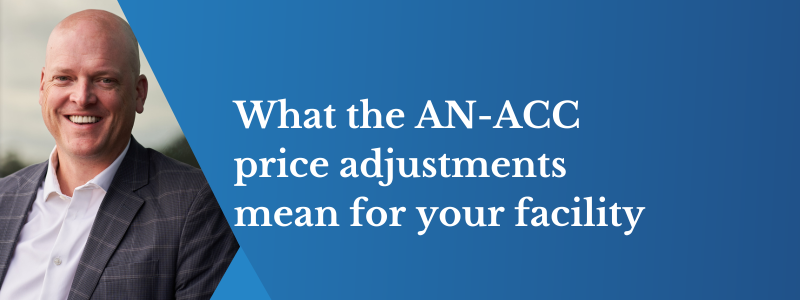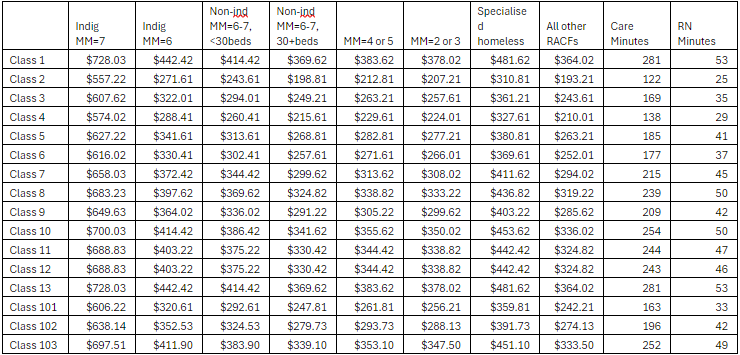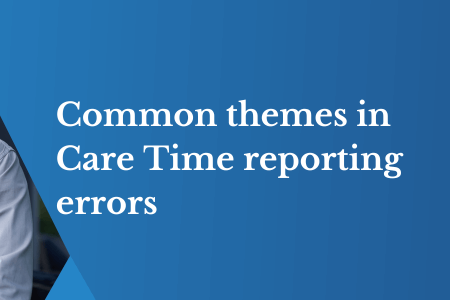AN-ACC price hike and Care Minute recalibration: Are you prepared?
September 19, 2024 | AN-ACC

By Tyler Fisher, Data Scientist
The change to the AN-ACC price in October will not just be an indexation to the National Efficient Price (NEP). The AN-ACC rates from 1 October 2024 will also see new weightings for each class’s NWAU. Additionally, Base Care tariffs will be adjusted, and new categories emerge for services in Modified Monash 2, 3 and 4. Similar changes to care minutes will be enacted. The base assumption will move from 200 to 215 minutes but there are also changes to the Relative Value Units (RVUs), which measure the general acuity of a person in any given class and determines the care minutes required.
This latest round of adjustments to the AN-ACC price and related components have again demonstrated that the department is prepared to continuously tweak the model. This highlights the importance of having AN-ACC calculations and transactions managed in a system rather than manually in spreadsheets or BI tools. Mirus Metrics has been built with the industry and is the only secure and fully functional AN-ACC management system available in the market today. These adjustments update automatically in the system and we create a forecast report of projected impacts of the changes on each of your cohorts of residents immediately the changes become available.
Contact us for more information on Forecast Reports and a free trial of Mirus Metrics.

Twenty-four per cent of all industry places are in a MM 2, 3 or 4, so many providers who were assuming a standard NEP indexation and a need to reach 215 minutes under existing RVUs, may find they have over invested and possibly face a subsidy shortfall. Even services in MM1 will need to recalibrate their roster position relative to their new claim profile and reconsider their reassessment strategies regarding which moves are beneficial and which are not.
Are we better off?
Overall, the industry Average Daily Subsidy (ADS) will move from $270 to $298 (+10.3%). Total case mix will increase only 4% from 206.4 to 214.5, and RN time will go from 40.7 to 43.8 minutes. This improves the operating margin by 4%, plus whatever saving can be realised by using ENs for up to 10% of the RN target. Most organisations will need to reassess their compliance and sustainability within their model of care and budget.
The pricing set for AN-ACC from October reflects a balanced approach considering inflation, wage rises, and other economic factors. With subsidy increasing more than the expected costs, further incremental price adjustments are unlikely. Stakeholders need to ensure compliance and adequate funding for workforce expenses within this new dynamic. Along with changing subsidies, there is a significant recalibration of the care minute requirements for each AN-ACC class. When we compare the relative starting points from October 2023 to one year later, industry subsidy has grown by 17% and average case mix has grown by 7%. Industry average case mix rises 4% as a result of the recalibration to a 215-minute target, so only 3% of the changes is based on resident claims.
Care Minute changes
Care minutes establish a minimum quantity of care for compliance. Residential aged care providers that do not have an adequate and appropriately skilled workforce are at risk of not meeting their requirement. The cost of meeting the care minute requirements leaves very little AN-ACC funding left over. Services must roster and manage AN-ACC accurately to align funding to the roster and not be in deficit. Any unforeseen event, like a large number of departures or significant increase in sick leave, can quickly send a service into deficit or non-compliance. Every service must determine the appropriate balance between Medicare claiming and rostering in order to remain compliant and sustainable. Cost assumptions can be modelled in comparison to claims and predicted resident movements in Mirus Metrics. Based on the cost assumptions used for AINs, ENs and RNs, operating margin is the proportion of subsidy remaining after subtracting the cost of the minimally compliant roster. Remember the good news is that the available margin for perfectly aligning the roster to the care minute requirement will increase by 4%.

What to do next?
A forecast report that assesses the impact to your Organisation and individual sites is available now for Mirus Metrics subscribers. If you are not yet using Mirus Metrics, our team are here to support you with a trial.


